Abstract
An immunogenetic study of autoimmune chronic active hepatitis (CAH) showed the relative risk (RR) for this disease was 11.6 for patients who were HLA-B8, 11.7 for patients who were DR3 and 2.3 for patients who were Gma+x+. Moreover, the Gm haplotype Gma+x+ was present in 18 of 40 (45%) patients with HLA-B8, but in none of 10 patients negative for HLA-B8, whereas in 180 healthy controls Gma+x+ was evenly distributed among those positive (24%) and negative (18%) for HLA-B8. The RR was lowest in patients lacking HLA-B8 but positive for Gma+x+. Relative to this low-risk group, the risk was increased 39 times in subjects with both HLA-B8 and Gma+x+, 15 times in subjects with HLA-B8 who were not Gma+x+ and twice in subjects who were neither HLA-B8 nor Gma+x+. Statistical analysis indicated that the three-factor effect (disease risk affected by non-additive effects of HLA-B8 and Gma+x+) was significant (P less than 0.01), as were the main effects of HLA-B8 (P less than 0.001) and Gma+x+ (P less than 0.02). Thus in the presence of HLA-B8, genes linked to Gma+x+, an immunoglobulin CH allotype, may contribute to the development of autoimmune chronic active hepatitis; in the absence of HLA-B8 these same genes appear to be inactive. This may indicate interactions between MHC gene products and VH gene products in the presentation and recognition of autoantigen(s) in autoimmune hepatitis.
Full text
PDF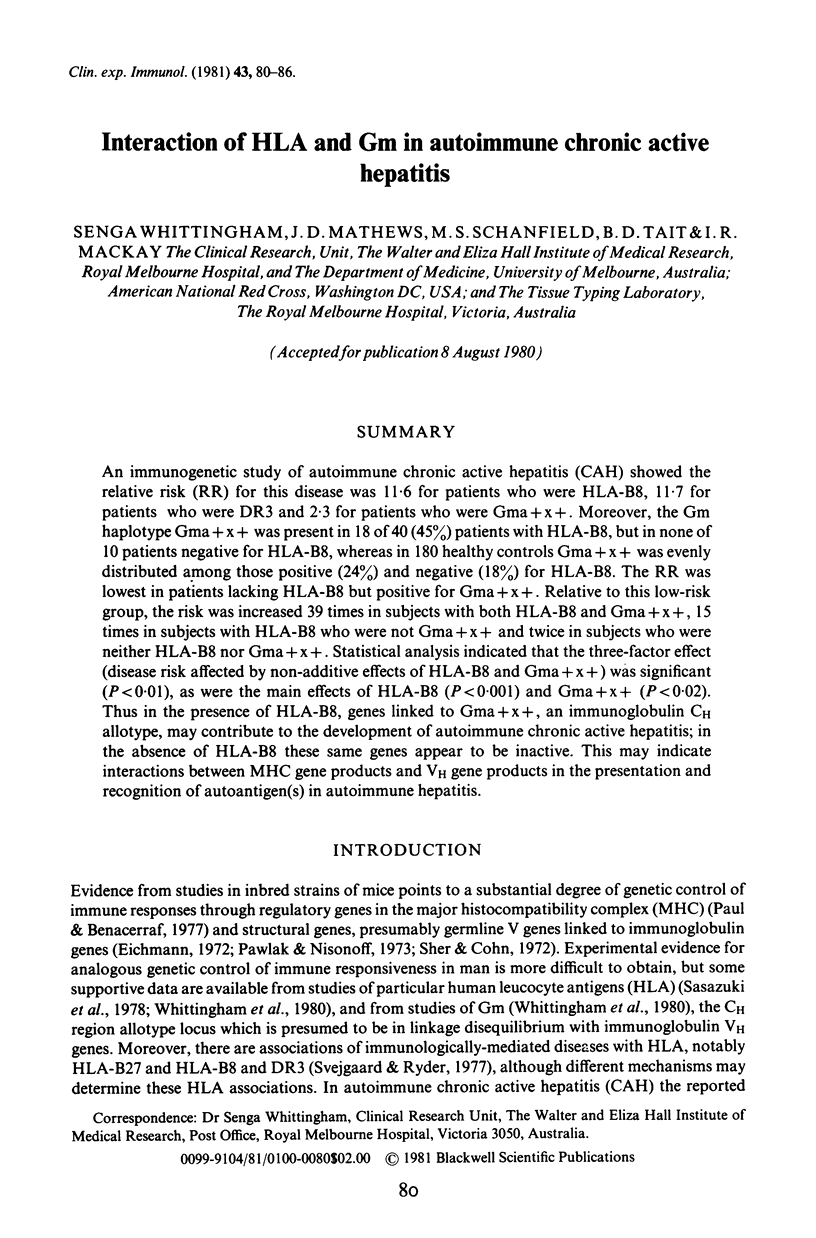
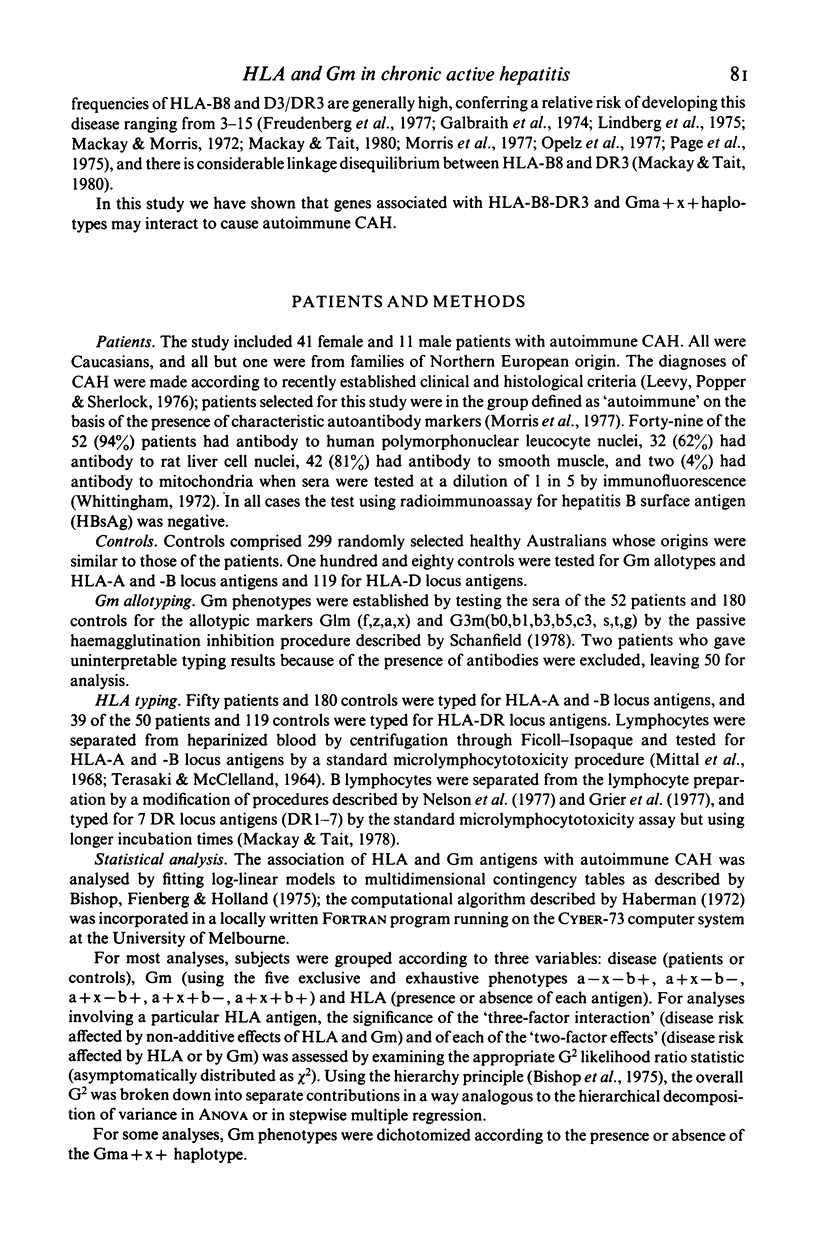
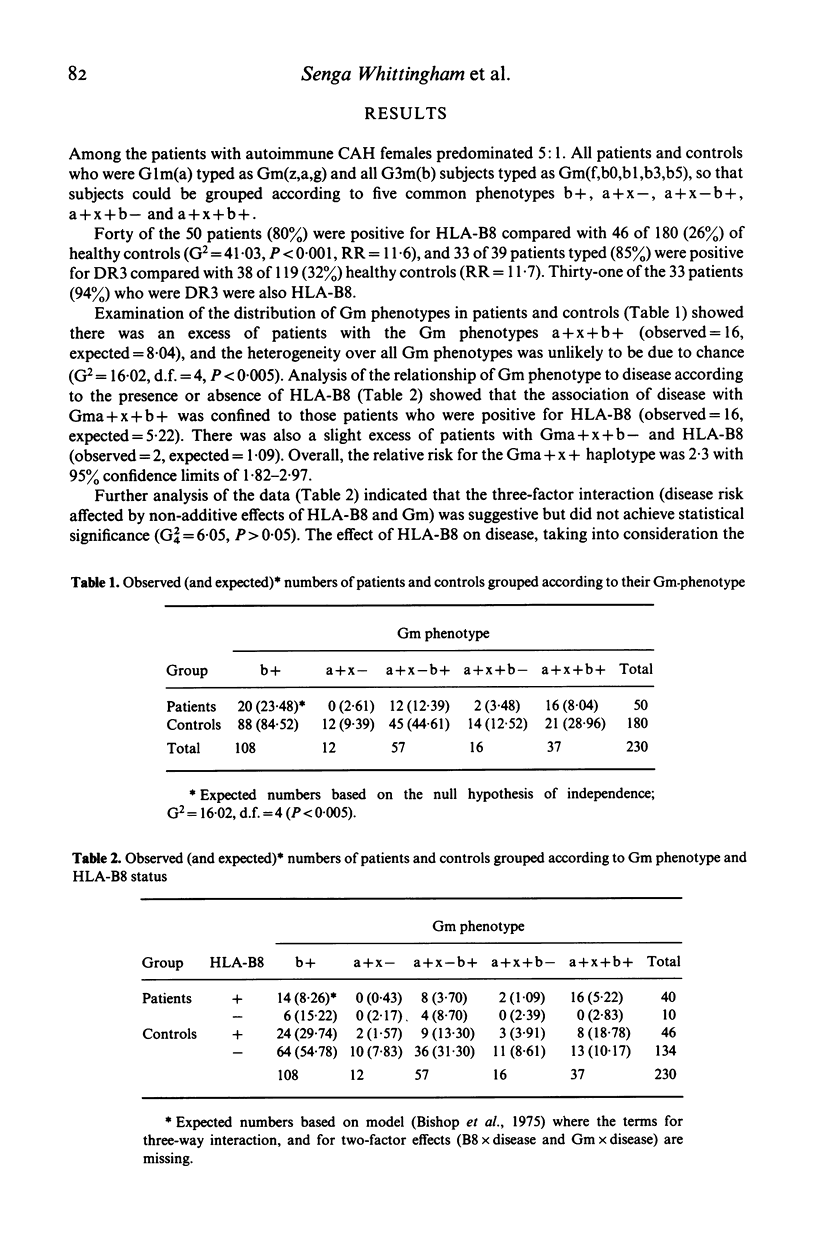
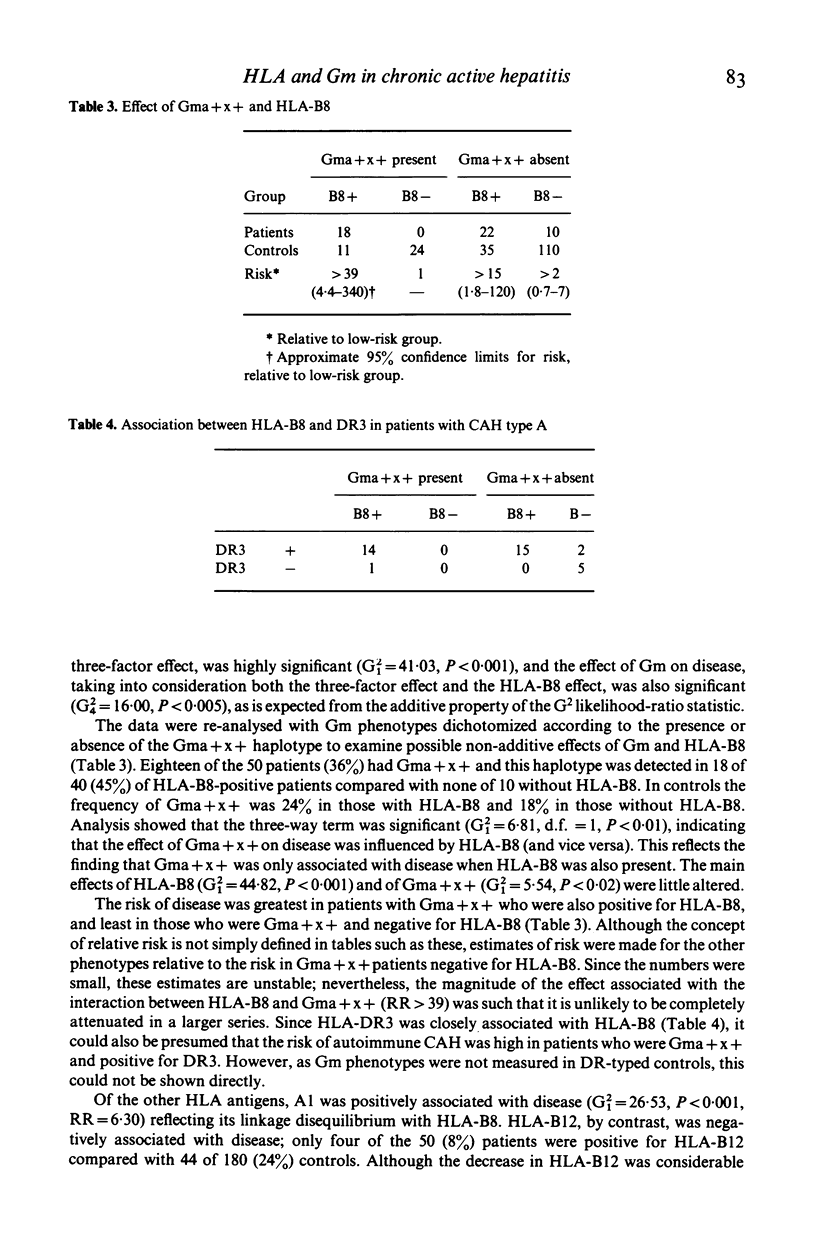

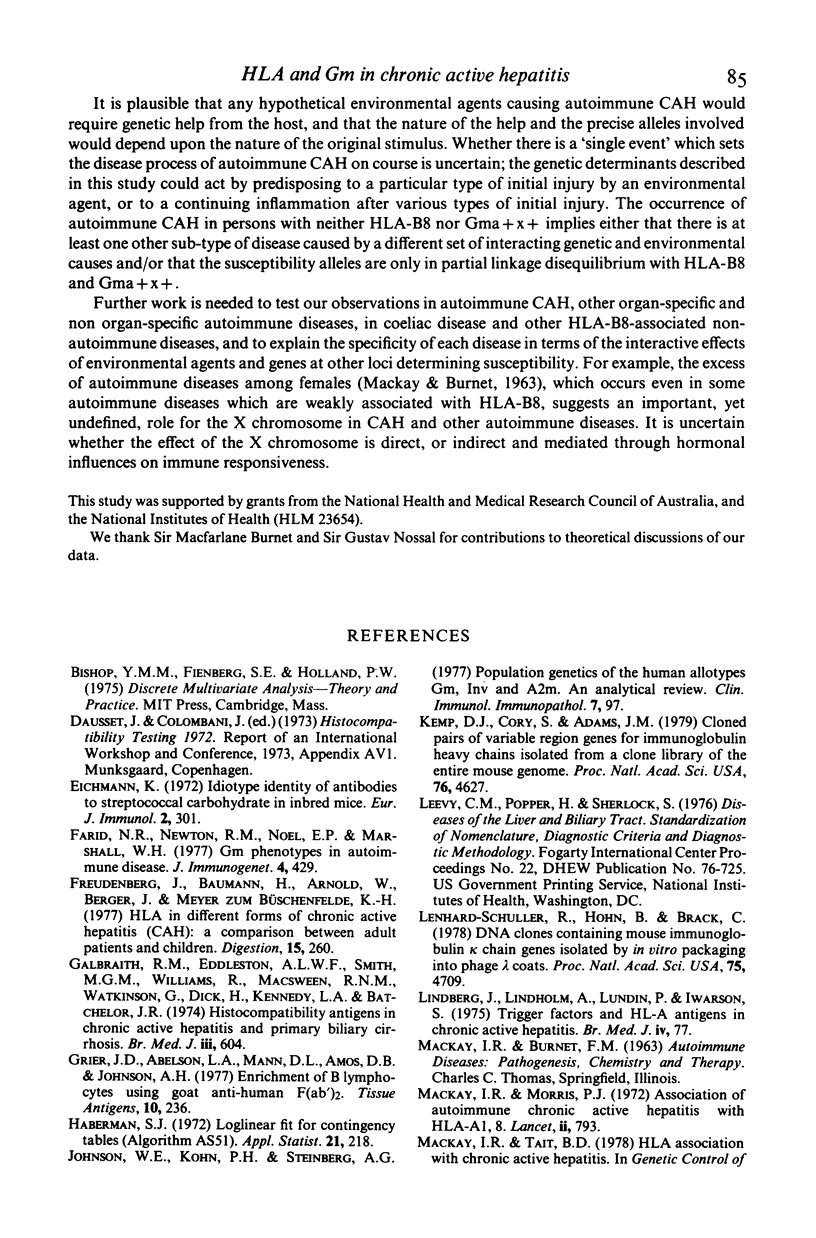
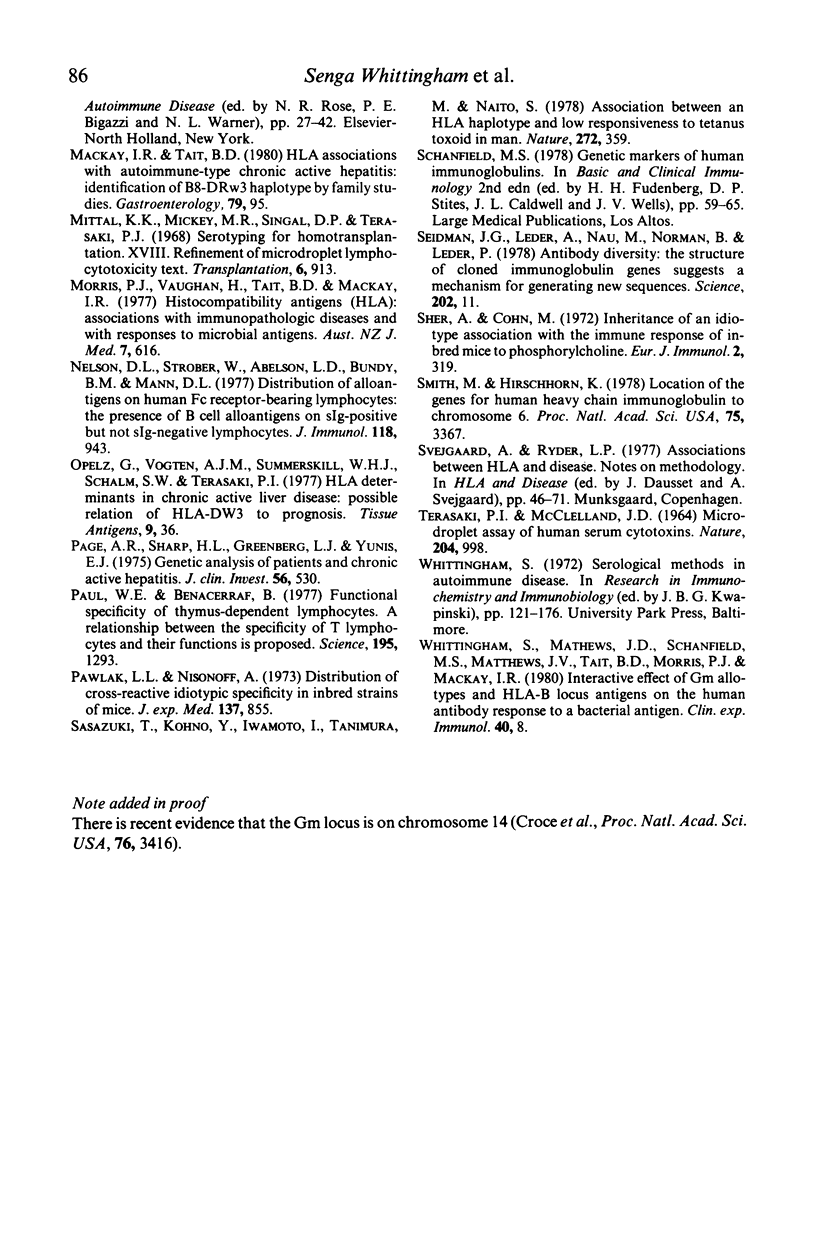
Selected References
These references are in PubMed. This may not be the complete list of references from this article.
- Eichmann K. Idiotypic identity of antibodies to streptococcal carbohydrate in inbred mice. Eur J Immunol. 1972 Aug;2(4):301–307. doi: 10.1002/eji.1830020402. [DOI] [PubMed] [Google Scholar]
- Farid N. R., Newton R. M., Noel E. P., Marshall W. H. Gm phenotypes in autoimmune thyroid disease. J Immunogenet. 1977 Dec;4(6):429–432. doi: 10.1111/j.1744-313x.1977.tb00927.x. [DOI] [PubMed] [Google Scholar]
- Galbraith R. M., Eddleston A. L., Smith M. G., Williams R., McSween R. N., Watkinson G., Dick H., Kennedy L. A., Batchelor J. R. Histocompatibility antigens in active chronic hepatitis and primary biliary cirrhosis. Br Med J. 1974 Sep 7;3(5931):604–605. doi: 10.1136/bmj.3.5931.604. [DOI] [PMC free article] [PubMed] [Google Scholar]
- Johnson W. E., Kohn P. H., Steinberg A. G. Population genetics of the human allotypes Gm, Inv, and A2m. Clin Immunol Immunopathol. 1977 Jan;7(1):97–113. doi: 10.1016/0090-1229(77)90034-4. [DOI] [PubMed] [Google Scholar]
- Kemp D. J., Cory S., Adams J. M. Cloned pairs of variable region genes for immunoglobulin heavy chains isolated from a clone library of the entire mouse genome. Proc Natl Acad Sci U S A. 1979 Sep;76(9):4627–4631. doi: 10.1073/pnas.76.9.4627. [DOI] [PMC free article] [PubMed] [Google Scholar]
- Lenhard-Schuller R., Hohn B., Brack C., Hirama M., Tonegawa S. DNA clones containing mouse immunoglobulin kappa chain genes isolated by in vitro packaging into phage lambda coats. Proc Natl Acad Sci U S A. 1978 Oct;75(10):4709–4713. doi: 10.1073/pnas.75.10.4709. [DOI] [PMC free article] [PubMed] [Google Scholar]
- Lindberg J., Lindholm A., Lundin P., Iwarson S. Trigger factors and HL-A antigens in chronic active hepatitis. Br Med J. 1975 Oct 11;4(5988):77–79. doi: 10.1136/bmj.4.5988.77. [DOI] [PMC free article] [PubMed] [Google Scholar]
- Mackay I. R., Morris P. J. Association of autoimmune active chronic hepatitis with HL-A1,8. Lancet. 1972 Oct 14;2(7781):793–795. doi: 10.1016/s0140-6736(72)92149-6. [DOI] [PubMed] [Google Scholar]
- Mackay I. R., Tait B. D. HLA associations with autoimmune-type chronic active hepatitis: identification of B8-DRw3 haplotype by family studies. Gastroenterology. 1980 Jul;79(1):95–98. [PubMed] [Google Scholar]
- Mittal K. K., Mickey M. R., Singal D. P., Terasaki P. I. Serotyping for homotransplantation. 18. Refinement of microdroplet lymphocyte cytotoxicity test. Transplantation. 1968 Nov;6(8):913–927. doi: 10.1097/00007890-196811000-00006. [DOI] [PubMed] [Google Scholar]
- Morris P. J., Vaughan H., Tait B. D., Mackay I. R. Histocompatibility antigens (HLA): associations with immunopathic diseases and with responses to microbial antigens. Aust N Z J Med. 1977 Dec;7(6):616–624. doi: 10.1111/j.1445-5994.1977.tb02318.x. [DOI] [PubMed] [Google Scholar]
- Nelson D. L., Strober W., Abelson L. D., Bundy B. M., Mann D. L. Distribution of alloantigens on human Fc receptor-bearing lymphocytes: the presence of B cell alloantigens on sIg-positive but not sIg-negative lymphocytes. J Immunol. 1977 Mar;118(3):943–946. [PubMed] [Google Scholar]
- Opelz G., Vogten A. J., Summerskill W. H., Schalm S. W., Terasaki P. I. HLA determinants in chronic active liver disease: possible relation of HLA-Dw3 to prognosis. Tissue Antigens. 1977 Jan;9(1):36–40. doi: 10.1111/j.1399-0039.1977.tb01077.x. [DOI] [PubMed] [Google Scholar]
- Page A. R., Sharp H. L., Greenberg L. J., Yunis E. J. Genetic analysis of patients with chronic active hepatitis. J Clin Invest. 1975 Sep;56(3):530–535. doi: 10.1172/JCI108121. [DOI] [PMC free article] [PubMed] [Google Scholar]
- Paul W. E., Benacerraf B. Functional specificity of thymus- dependent lymphocytes. Science. 1977 Mar 25;195(4284):1293–1300. doi: 10.1126/science.320663. [DOI] [PubMed] [Google Scholar]
- Pawlak L. L., Nisonoff A. Distribution of a cross-reactive idiotypic specificity in inbred strains of mice. J Exp Med. 1973 Apr 1;137(4):855–869. doi: 10.1084/jem.137.4.855. [DOI] [PMC free article] [PubMed] [Google Scholar]
- Sasazuki T., Kohno Y., Iwamoto I., Tanimura M., Naito S. Association between an HLA haplotype and low responsiveness to tetanus toxoid in man. Nature. 1978 Mar 23;272(5651):359–361. doi: 10.1038/272359b0. [DOI] [PubMed] [Google Scholar]
- Seidman J. G., Leder A., Nau M., Norman B., Leder P. Antibody diversity. Science. 1978 Oct 6;202(4363):11–17. doi: 10.1126/science.99815. [DOI] [PubMed] [Google Scholar]
- Sher A., Cohn M. Inheritance of an idiotype associated with the immune response of inbred mice to phosphorylcholine. Eur J Immunol. 1972 Aug;2(4):319–326. doi: 10.1002/eji.1830020405. [DOI] [PubMed] [Google Scholar]
- Smith M., Hirschhorn K. Location of the genes for human heavy chain immunoglobulin to chromosome 6. Proc Natl Acad Sci U S A. 1978 Jul;75(7):3367–3371. doi: 10.1073/pnas.75.7.3367. [DOI] [PMC free article] [PubMed] [Google Scholar]
- TERASAKI P. I., MCCLELLAND J. D. MICRODROPLET ASSAY OF HUMAN SERUM CYTOTOXINS. Nature. 1964 Dec 5;204:998–1000. doi: 10.1038/204998b0. [DOI] [PubMed] [Google Scholar]
- Whittingham S., Mathews J. D., Schanfield M. S., Matthews J. V., Tait B. D., Morris P. J., Mackay I. R. Interactive effect of Gm allotypes and HLA-B locus antigens on the human antibody response to a bacterial antigen. Clin Exp Immunol. 1980 Apr;40(1):8–15. [PMC free article] [PubMed] [Google Scholar]


